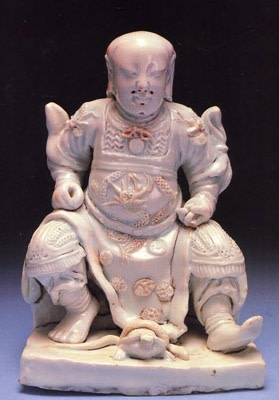The Lord of the Night Sky, at his feet a tortoise encircled by a serpent. The tortoise ruled in one of the cardinal points of the Chinese compass, the Cold North.
The glaze is a bluish white pooling to an irridescent blue in the folds of his garment. The base is solid and glazed in parts, the unglazed parts revealing a reddish body.
Literature
Hsuan-T'ien Shang-Ti, The Lord of the Night Sky, also called chen Wu, was first heard of during the Chou period (1154-1121 BC). At fifteen years of age he left his parents and under the tutelage of the patriarch Tzu-hsu learned the wonderful doctrine and was given a magic sword. On the peak of a mountain he practised for forty-two years the exercises which brought him the ability to float, etc. Having mastered this he was invited to the celestial regions, where he had conferred upon him the title Hsuan-T?ien Shang-Ti, First Lord of the Highest Heaven. His name Hsuan Wu is said to be the name of the North Star.
The name Hsuan Wu was changed to Chen Wu by the Sung Emperor Chen tsung (AD 998-1023) because Hsuan was part of his own name. In the Yuan Dynasty he was granted the honorary title of Leading Good and Majestic Saint, First Lord of the Highest Heaven.
Mention is made in the Ming-Shih of a temple built in 1416 for sacrificing to Hsuan Wu under the title of Veritable Saintly and Helpful Master of the Pole Star.
This figure was exhibited in the Ostasiatiska Museet in Stockholm in 1968, (object 32), and was given a full page illustration in the exhibition catalogue. It formed part of the well-known collection of the late Gustav Hillestrom.
See Solveig Gray Anita Gray, Catalogue 1, pl.5 pp.4-5 for an illustration and description of this object.

